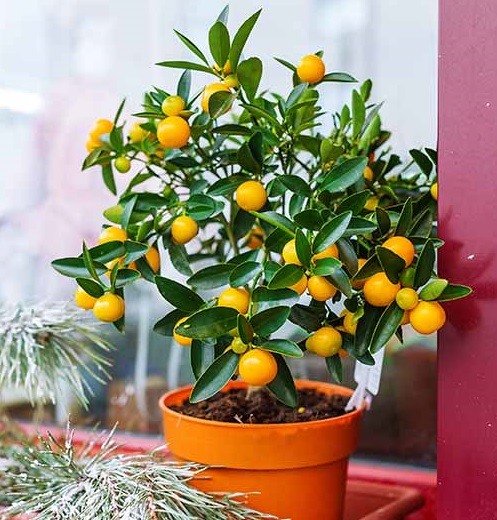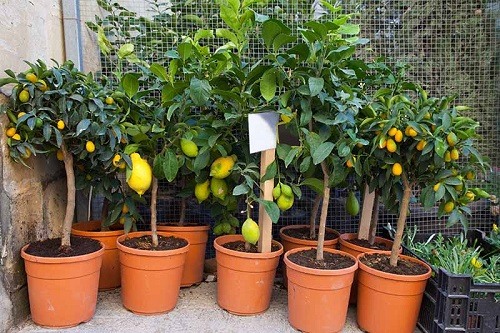An indoor dwarf orange tree has dark green foliages with highly scented blooms. These vibrant foliages and fragrances from flowers help to bring a tropical feeling to a home. Growing this ornamental orange tree is a no-brainer task regardless of individual experience.
An indoor orange tree care involves the provision of well-draining soil, 8-12 hours of bright sunlight, a regular watering routine, and a temperature range of 68-85oF (20-29oC). Provide also 50-70% humidity and frequent application of citrus fertilizer.
The information in this guide will teach you everything about growing and caring for an indoor mini orange tree. You’ll also learn other hidden facts on the mini orange tree care regimes and problems hindering indoor successful growth.

What Does an Indoor Orange Tree Look Like?
A dwarf orange tree is among the best indoor citrus trees. These citrus trees houseplants can tolerate the indoor weather-climate fluctuations without becoming fussy.
An indoor orange tree has shiny dark-green leaves with scented flowers. The fruits’ brilliant colors and flower fragrance is the reason behind the citrus tree demand in the market.
This ornamental orange tree can reach 3-6 ft under appropriate growing conditions. It usually blooms between January and December.
The lovely aroma from the flowers helps to freshen and purify the air around the home. The orange fruits are an excellent addition to an individual diet.
The best indoor orange trees to consider are Tahitian, Satsuma, and Calamondin. These types of indoor orange trees require similar growing conditions.
Tahitian oranges have no thorns and produce sweet fruits. The small sweet fruits have a taste of lemon and tangerine mix. Satsuma oranges are tangerine in nature due to their flower fragrances.
Calamondin oranges are small and sour. It is strictly grown as an ornamental orange tree by many season growers across the United States of America and Australia.
The mini orange tree care routine is similar to the indoor lemon tree. Begin by choosing the best indoor orange variety that suits your home or apartment.
Indoor Orange Tree Care Details
| Origin | Southern California |
| Scientific Name | Citrus madurensis |
| Common Names | Indoor orange tree Mini orange tree Dwarf orange tree |
| Maximum Growth (Approx.) | 3-6 ft tall |
| Light Requirements | 8-12 hours of bright sunlight |
| Pot Type | Pot with drainage holes and made from non-porous materials. |
| Soil Type | Lightweight and well-draining potting mix. |
| Watering Frequency | Thrives in slightly moist soil. |
| Humidity Requirements | About 50-70% humidity level. |
| Temperature Range | 68-85oF (20-29oC) |
| Fertilizer Application | Feed the orange trees once a week during spring and summer with a liquid citrus fertilizer. |
| Pruning and Maintenance | Minimal pruning requirements. Pinch the growing stems to encourage a bushy appearance. |
| Re-potting | Once every 2-3 years due to the root-bound issue. |
| Pests and Diseases | Pests: Scales and Spider Mites Diseases: Leaves dropping and Root rot |
| Toxicity Level | Non-toxic to humans and pets. But leaves have a bitter taste. |
How to Care for an Indoor Orange Tree
Choosing the Best Indoor Orange Tree Type
There are different types of orange trees for growing indoors. Choose a dwarf orange tree that will produce fruits and flowers right away.
I recommend going for a 2-3-year-old Calamondin orange tree since it is tolerant to indoor conditions. It is also a perfect choice for both season growers and beginners.
But most ornamental orange tree types have similar care routines. Buy mini orange trees from a reputable nursery to avoid diseases or inferior species. (Check the Best Deals on Amazon).
Best Pot for Indoor Orange Tree
Dwarf orange trees do best in a pot with drainage holes and allow adequate root aeration. I recommend buying a pot made from non-porous materials.
These pots are lightweight to facilitate indoor and outdoor movement. Besides that, non-porous materials can hold moisture for an extended period.
Other excellent options to consider are terracotta, ceramic, and wooden pots. But these pots require a strict routine for monitoring soil moisture.
The golden rule is to consider containers with drainage holes. Remember to start with small pots and move to larger ones as the dwarf orange tree grows.
Deep pots (Check Best Deals on Amazon) are the best option for growing most citrus tree houseplants. It inhibits the orange tree from overgrowing and causing imbalance.
Indoor Orange Tree Soil Requirement
An indoor mini orange tree does best in lightweight and well-draining soil. The lightweight potting mix allows adequate air circulation around the root system.
Consider potting soil that contains perlite or vermiculite. These inorganic compounds help to improve aeration and soil drainage around the roots.
Another option is to combine potting soil with wood chips, coarse sand, and small pebbles. Avoid soil mix that retains a lot of moisture for an extended period.
Soak the potting mix until the excess water runs through the drainage holes. Ensure the potting soil does not get soggy in the long run.
Light Requirement for Indoor Orange Tree
Dwarf orange trees need bright sunlight to flower and produce fruits. Indoor orange trees can thrive under bright indirect sunlight without facing any problem.
Move the mini orange trees near the window that receives bright indirect sunlight. Expose the orange trees to sunlight for about 8-12 hours daily.
The hot sun in the summer can harm your indoor orange trees. Move these dwarf orange trees away from the south or west-facing windows. Too much direct sunlight might burn the leaves.
I recommend moving the indoor orange tree outside during the early morning or late evening sunlight. The sun rays’ intensity won’t ruin the appearance and well-being of your citrus tree.
How to Water an Indoor Orange Tree
Indoor orange trees are picky when it comes to watering routines. The golden rule is to monitor these mini orange trees to meet their watering requirements.
Inspect the potting soil to determine its moisture content. Insert the index figure in the potting soil to check the moisture level. Soak the mix if it is dry to rehydrate your citrus tree houseplant.
Develop a strict watering schedule for your indoor orange trees. Mini orange trees have more water requirements during spring and winter. Reduce watering frequency in fall and winter.
Keep in mind that mature dwarf orange trees need more water for sustenance and promotion of fruit development. Juvenile indoor orange trees need less water.
Humidity Requirements for Indoor Orange Tree
All types of orange trees are tropical plants that thrive in a warm and humid environment. The best indoor humidity level for a mini orange tree is about 50-70%.
Mist the mini orange tree leaves more often to replicate the tropical climate at home. Another excellent option is to use a humidifier to boost indoor humidity levels.
I use a digital thermometer and hygrometer to monitor my indoor humidity level. These instruments help to create a conducive environment for growing mini orange trees.
Indoor Orange Tree Temperature Range
The ideal daytime temperature for an indoor dwarf orange tree is 68oF (20oC). Avoid indoor temperature fluctuations to keep the orange tree happy and healthy.
Ensure the night-time temperature is lower than 5-10oF. Most types of indoor orange trees prefer cooler temperatures at night.
Remember to keep your mini orange tree away from heat and cold drafts. Both drafts tend to ruin the citrus tree’s appearance and happiness.
Indoor Orange Tree Fertilizer Needs
Mini orange trees are among few tropical plants that need more nutrients to grow and blossom at home. Feed your dwarf orange trees once a week with liquid citric fertilizer during spring.
Indoor orange trees do not go dormant in cold months. Use a winter citrus fertilizer to feed your mini orange tree. Ensure the fertilizer is rich in nitrogen, potassium, and phosphorus.
Do Orange Trees Need Pruning?
Dwarf orange trees are slow-growing and require minimal pruning routines. Pinch the stems during spring and summer to enhance the bushy appearance.
Remove unhealthy or damaged branches during fall and winter. Use a sterilized pruner (Check the Best Deals on Amazon) to snip these branches from the parent tree.
How to Repot Indoor Orange Tree
Mini orange tree needs transplant every 2-3 years after overgrowing the current pot or showing signs of root-bound issues.
Use a larger container than the current one during spring. Allow the potting soil to dry before transplanting to a new container.
Exercise ultimate care and attention when re-potting the citrus tree houseplant. Soak the soil after re-potting and provide other essential indoor orange tree care regimes.
When Do Orange Trees Flower?
Mini orange trees do bloom under bright sunlight. The small white blossoms tend to fill your indoor space with sweet fragrances.
Most orange trees do flower during the winter months. Every season grower needs to pollinate the orange trees to enhance fruit development. Insects for pollination are unavailable during winter.
I recommend the use of pollination tools (Check Best Deals on Amazon). These gadgets will help you move pollen from one flower to another.
Common Problems and Solutions
Pests
Dwarf orange trees are less susceptible to pest infestations. But this does not make mini orange trees invincible to insect infestation.
Aphids, mealybugs, spider mites, and whiteflies are the leading pests that attack indoor orange trees. These sap-sucking creatures are due to poor ventilation and watering issues.
I recommend the use of neem oil or horticultural soap spray to get rid of these insects. Be sure to inspect the dark green foliages more often to combat insect infestations at early stages.
Diseases
Citrus tree houseplants are less vulnerable to diseases. Sooty mold and root rot are the leading diseases that attack most indoor orange trees.
Sooty mold is due to insect infestation and results in black spots on the leaves or twigs. Over-watering is the leading cause of root rot.
Use fungicides to treat sooty mold and re-pot indoor orange trees to overcome root rot issues. Be sure to develop a strict watering routine to avoid getting the potting soil soggy.
Leaves Dropped in the Winter
Mini orange trees hate the cold weather of January and February. The cold weather climate will make your dwarf orange tree drop its leaves.
Install grow lights (Check Best Deals on Amazon) to protect the mini orange tree from dropping all its leaves. Besides that, move the orange tree to a region with a warmer temperature.

Frequently Asked Questions
Why Are the Leaves of My Indoor Orange Tree Turning Yellow?
Yellow leaves on the indoor orange trees are due to nutritional deficiency. Consider feeding your indoor orange tree with citrus fertilizer rich in nitrogen and potassium.
Why Is My Indoor Orange Tree Losing Leaves?
Indoor temperature change is the reason behind the orange tree losing leaves. Cold and hot drafts are the causes of an orange tree losing leaves.
Move the citrus tree houseplant to a region that does not experience sudden temperature changes. It is the best method of combating orange trees losing leaves.
Why Is My Indoor Orange Tree Dying?
Root rot due to overwatering is the reason behind the orange tree dying. Consider re-potting the citrus tree houseplant to save it from dying.
Conclusion
Growing an indoor orange tree is an excellent way of adding color to your home during the winter season. The delicate flowers with fragrance help to freshen and purify the indoor air.
My indoor orange tree care guide will help you grow any citrus tree houseplant without any challenges. The citrus tree care tips have been proven and tested to work.
Have you ever had success in growing indoor citrus trees? Share your experiences and questions in the comment section below. (Sources: University of Minnesota)
You May Also Like
